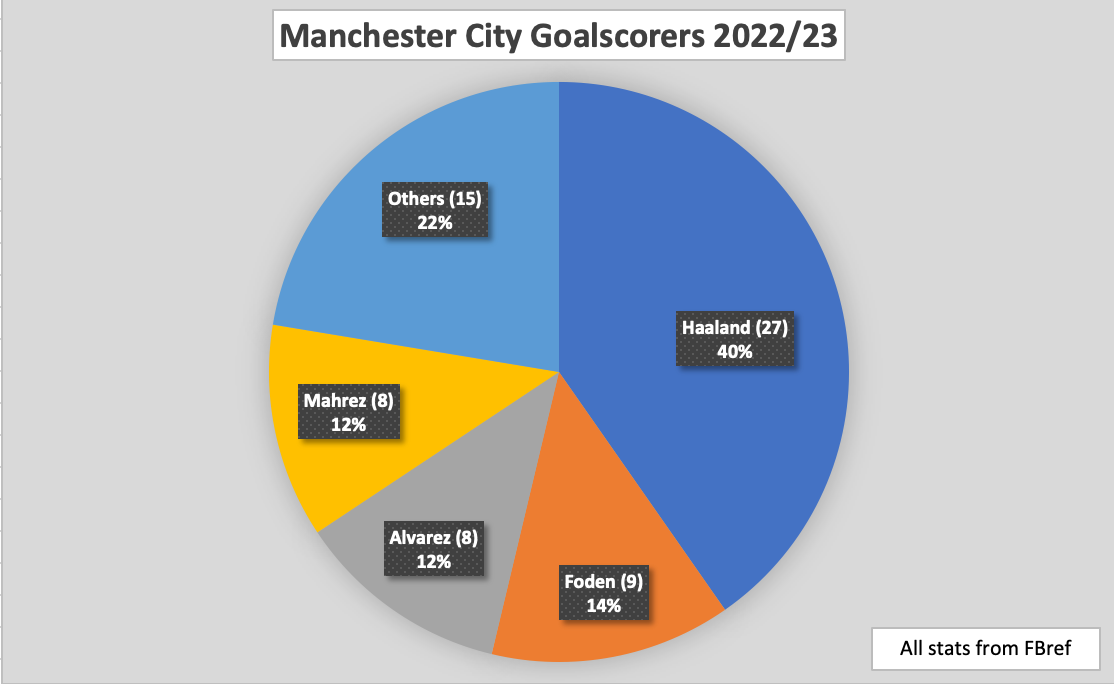Are Manchester City worse with Erling Haaland?
Please put your pitchforks down till the end of the presentation.
All data in this newsletter is taken from FBref and is correct as of the time of writing.
This is not a reactionary statement in its entirety, though the timing of it may have something to do with recent results.
I had always planned of taking a look at Erling Haaland’s start to life at Manchester City at some point during the season, but their back-to-back fixtures with Chelsea and the reaction surrounding them have made it a better time than any to write this.
City struggled to a 1-0 win against Chelsea on Thursday 5th January with Haaland having one of his worst games so far in a sky-blue shirt; scoring no goals from an xG of 0.9 (3 shots, 0 on target). He was still getting in the positions, he couldn’t finish his dinner.
Fast forward a few days to Sunday, City played Chelsea in the FA Cup, and Pep Guardiola’s side looked much better. Haaland was on the bench.
You could focus on the scoreline, a 4-0 thrashing, but seeing how 3/4 of City’s goals came from set pieces that might be redundant. However, what you can talk about was how City looked much more fluid going forward and looked more like the unstoppable force they were in previous seasons.
This has led many fans and writers alike to ask the question: ‘Have City taken a step backwards by signing and consequently accommodating the Norwegian?’
Well, let’s take a look.
Now we need to start by making an important distinction, individually Haaland is having a great season at Manchester City.
Across the Premier League and Champions League, he has scored 27 goals from an xG of 18.2. To put this another way, he has taken 77 shots to reach that tally, meaning he has a conversion rate of 33.77%
To put this into perspective when Robert Lewandowksi scored a career-best 55 goals for Bayern Munich in a single season to win the treble, he had a conversion rate of 35%.
(The xG overperformance is fine, he did it at Dortmund and Salzburg as well)
Haaland broke the record for the number of games to reach 20 Premier League goals by 7 (Kevin Phillips previously held the record with 21 games) and if he keeps this goalscoring rate up he will likely smash the record for the number of goals in a single season as well, and that doesn’t matter if you subscribe to that record being held by Salah with 32 goals (in a 38 game season) or Alan Shearer/Andy Cole with 34 goals (in a 42 game season).
This is his first season in the Premier League and he is only 22, we should all be scared.
But while Haaland feasts upfront as City’s focal point, how are the rest of the team faring?
Manchester City in 2021/22 subscribed to something I like to refer to as the ‘Everybody Eats Manifesto.’ They scored 146 goals across all competitions, with 18 different goal scorers and seven of those hitting double figures.
City this season have scored 67 goals, with only Haaland hitting double figures so far (Foden sits on nine goals and Alvarez on eight). Seeing as we haven’t had an entire season, comparing total goals won’t yield much worth, but you can look at how those goals are spread.
In 2021/22, City’s top scorer across all competitions was Riyad Mahrez with 24 goals. He scored 16.44% of City’s goals and the rest of the spread you can see here (all goalscorers in double figures are named):
And this is the spread of goals for City this season (so it looks like a graphic I have named Foden, Alvarez and Mahrez):
With the current distribution, Haaland would have to score 59 goals for Manchester City to hit their goal tally from last season, but this might not be as difficult a task as you’d think.
To hit this, Haaland needs to score 32 goals in City’s remaining games this season. If he continued his current rate of scoring (1.45 goals per 90 minutes played) he would score 30.45 goals in City’s 21 remaining Premier League games alone.
Haaland will not play every single minute of City’s remaining games, but with Guardiola expecting to go far in the FA Cup and the Champions League alongside their participation in the later stages of the EFL Cup, it’s not out of the question that Haaland hits this high target.
But as I said before, Haaland himself is having a good season, that was never a debate.
What this shows is the rest of the team is disproportionately relying on him to get the goals, moving away from the ‘Everybody Eats Manifesto’, much like Manchester United did when they re-signed Cristiano Ronaldo.
The caveat to this is it could balance out throughout the season and if Halaand scores 50+ and a few others score 10+ then I doubt anyone cares (but as I’m about to say the only reason we’re talking about this is that City aren’t first).
So what deserves further analysis is how Haaland’s presence affects how the rest of the team plays and whether the rest of the team can get City over the line when Haaland is on the pitch and he doesn’t score, because those are the moments that will define the title race.
Manchester City are second in the table behind Arsenal and have third (Newcastle) and fourth (Manchester United) places hot on their tail.
If they were first and cruising like usual, there likely wouldn’t be a debate surrounding Haaland, at least overtly anyway. Some writers would be quietly noting away that City could actually be worse with the 22-year-old so they can talk about it when they wouldn’t be unceremoniously cooked online.
Of course, there is the obvious approach to this argument that focuses on Haaland’s involvement in the build-up and interplay.
Across the PL and CL in 2022/23, Haaland averages just under 21 touches per game and 10 completed passes. Gabriel Jesus by comparison averaged 33.2 touches per game and just under 21 passes last season (and it should be noted that this average is dragged down by cameos from the bench).
As the focal point upfront this makes sense however, Haaland starting position is meant to be much higher so he can get onto the end of moves, rather than dropping deeper to help in the build-up.
This tracks when you look at his heatmap for the season (as provided by Sofascore):
The two areas he mainly occupies are on the halfway line, waiting for opportunities to run in behind if City wants to attempt a fast break when they win back possession, or inside the box.
So if the idea is to get the ball to Haaland, then the next best place to look will be at the rest of the side’s shot-creating actions (SCAs).
City’s strength has always been the sheer volume of shots they can create across the board. They completely overwhelm opponents and then by the law of probability, some of them go in.
In 2021/22 City averaged 18.8 shots per game, in 2022/23 this has dropped to 16.7. Given that Haaland has taken 82 of their shots, 24 more than Kevin de Bruyne and more than double Foden’s tally, it’s safe to assume that the reason for the dropoff is that instead of taking shots, forwards are now trying to work it to the Norwegian.
And at first glance, this is reflected in City SCAs per 90, as in many cases, they are better.
Kevin de Bruyne has gone from 6.05 SCAs per 90 in 2021/22 to 6.75 in 2022/23; the same is true for Mahrez who went from 4.49 to 5.79 and Foden who went from 3.69 to a whopping 5.08.
Most of the drops are not significant as well, Gundogan went from 4.16 SCAs per 90 to 3.99 this season and Grealish’s remain at over 5 per 90.
But then you come to the first, rather significant issue at left-back.
Joao Cancelo had 3.54 SCAs last season, this campaign has dropped to 2.83 (he also took 98 shots last year to score 3 goals but that’s by the by). That doesn’t seem that bad right? Well, it’s not really Cancelo that’s the issue, though his relegation to the bench in recent weeks has played a part. It’s the absence of Oleksander Zinchenko.
While Sergio Gomez has put up modest numbers for City when he has played, it is clear he is not yet trusted by Pep who prefers to use Nathan Ake out of position.
Zinchenko averaged 3.55 SCAs per 90, and Ake only averages 1.05, meaning when City need to make changes or rotate there is a severe drop-off. Furthermore, since Ake is a natural centre-back, he is less likely to go forward which limits the interplay between City’s left-hand side.
And with that, we get to the core of City’s issues this season, something I have been covertly feeding you for this entire article, their biggest problem isn’t adapting to Haaland; it’s that they’ve sold all their depth.
Erling Haaland has played 22 games for City and only failed to score in four of them, resulting in two wins, a draw and a loss.
His performance against Bournemouth showed what he can offer as well as scoring despite him not getting on the scoresheet (and only registering seven touches of the ball); occupying defenders and creating space for his teammates to score four goals.
From watching City it is clear that they are currently worse with Haaland, but it’s still too early to make the sweeping statement that it’s because of him.
They are less fluid, the goals are not coming from everyone and of course as I previously stated, they are second, but this could be from a lack of form or other factors not related to the forward line, such as the team conceding more goals (0.94 goals per game this season compared to 0.68 goals last season).
Plan A is obviously to work it to Haaland, but only time will tell whether that is a bad strategy. The immediate problem is that City have no Plan B (or at least they have not discovered it yet).
They are fully committed to the Haaland project, they sold two players, Sterling and Jesus, who scored 30 between them and were more in line with the sort of forwards that Pep Guardiola likes to use.
Yes, they tried to replace them with the likes of Alvarez, but given the Argentinian is usually in direct competition with Haaland for minutes or played out wide, he isn’t going to prop their numbers up consistently.
Factor in other departures such as Zinchenko, players beginning to age out like Gundogan, consistent injury issues with the likes of Aymeric Laporte and Kalvin Phillips and some of the players not quite being up to the quality of who they replaced, like Grealish, and you can say for this season in isolation, City’s depth is not at the standard where we can say ‘their second XI would win the league as well’ anymore.
However, the one thing that City has on their side is time.
This is no longer Pep Guardiola’s last season in Manchester as he has extended his contract until 2025. Therefore he has the time to refine and rebuild at the Etihad.
Though another team may take advantage of their slight blip this season (honestly it’s still theirs to lose because I think we’re overreacting about how bad they are), looking at the underlying data you’d back them to bounce back once the moving pieces begin to click together.







